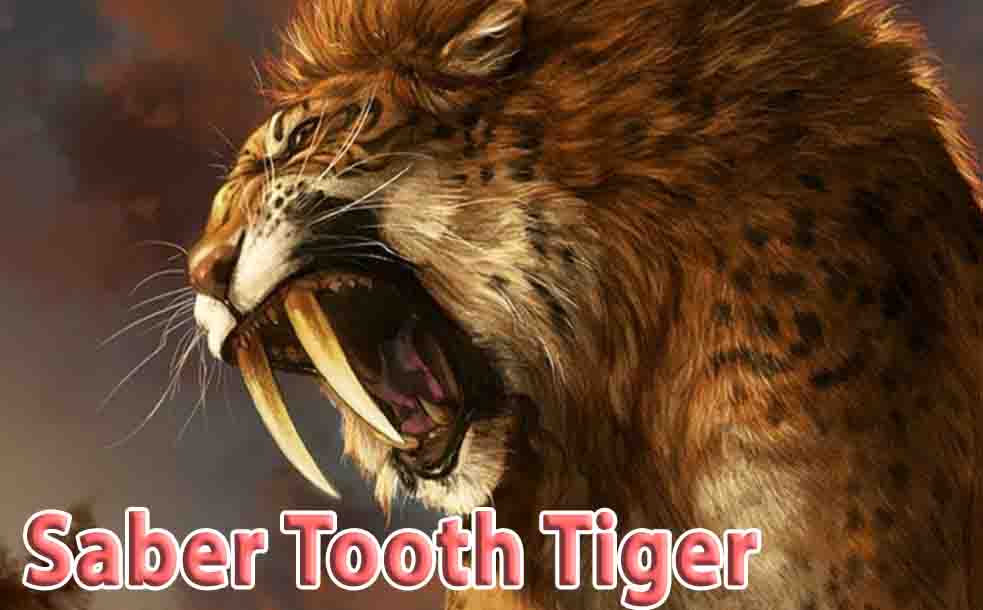The Basics
In the genus Smilodon, the saber tooth tiger is one of the most widely known species of saber toothed cats. A pair of elongated teeth in the upper jaw gave this extinct cat its name. During the Pleistocene Epoch, saber tooth tigers roamed North and South America. About 10,000 years ago, it became extinct.
The cats are not related to the modern-day tigers found in Asia, contrary to their name. Saber tooth tigers are named for their large canine teeth that could grow to over 7 inches long. It was able to slice soft tissue with its narrow, curved, and extremely sharp teeth.
While they were quite fragile, hitting bone as opposed to flesh might have caused them to break.
Skeletons and fossils of saber tooth tigers have been discovered by scientists. Hence, saber tooth tigers had short limbs and were large cats. Both in size and color, these cats would have resembled the modern-day African lion (Panthera Leo), although they are not related.
Large herbivores such as bison and deer were preyed upon by these dominant predators. Woolly mammoths are also believed to have been eaten occasionally by them.
The females of these large cats are likely to have given birth to a maximum of three cubs in the spring. Saber tooth tiger cubs are not well known, but researchers think they were born blind like other cats.
Natural predators did not exist for them. They are believed to have been hunted to extinction by humans.
Interesting Insights from the Saber Tooth Tiger!
Saber tooth tigers were well known for their enormous canines, which gave them their name. The saber tooth tiger was not just successful because of these biological adaptations. Let’s examine this closely.
Physical Adaptations – Head
Saber tooth tigers had several adaptations that allowed them to grow such large teeth. In addition to its wide gape, the cats were able to open their mouths to a maximum of 120 degrees.
As opposed to today’s lions, which can open their mouths only 60 degrees, this is double that of today’s. For the cats to be able to utilize their large teeth, which could be as long as 28 cm, this wide gape was necessary.
Furthermore, it had a modification on its skull that enabled strong neck muscles to attach, allowing it to lower its head. In other words, it hunted by stabbing and slashing at its prey with its teeth.
Physical Adaptations – Limbs
There was a difference between the length and thickness of the limbs of these cats and other felines. Their bones were also denser and their abductor muscles were powerful. The cats would have been able to wrestle their prey with more power and stability because of this.
Saber tooth tigers were likely ambush hunters who stalked their prey due to these physical adaptations. This theory is further supported by the structure of their head (as mentioned above) and their teeth.
Another adaptation of saber tooth tigers supports the theory that they were ambush hunters. The Saber tooth tigers did not have a tail like modern-day cats, such as lions and cheetahs. While chasing their prey, big cats use their long tails to provide stability and balance.
Big cats would have been more likely to hide and wait for their prey without this long tail. With their impressive canines, they would have delivered a fatal bite once they had surprised their prey.
Social Behaviour
A saber tooth tiger was a social animal, unlike modern cats such as tigers and house cats. As with lions, they are believed to live in packs and have social structures.
This theory is supported by fossils found throughout North America. Some of the Smilodon fossils found in the La Brea tar pits show signs of fractures, severe crushing, crippling arthritis, and other degenerative diseases. A solitary hunter would likely have died before these wounds healed if these cats were solitary hunters.
There was extensive healing and regrowth on many of the bones found. It is highly likely that other cats cared for the injured cats after their injuries. They were at least able to feed because of the other cats.
It appears that fights sometimes broke out between female saber tooth cats, based on the bones from other cats.

